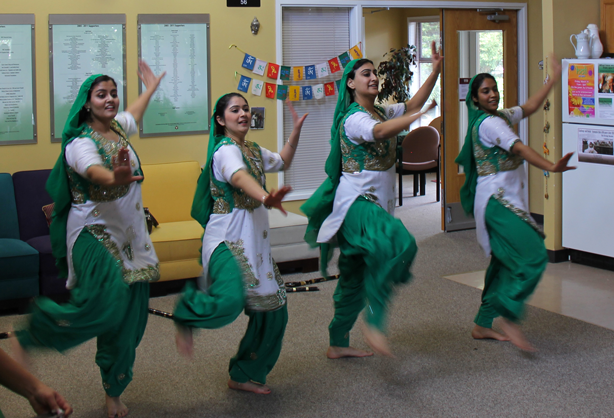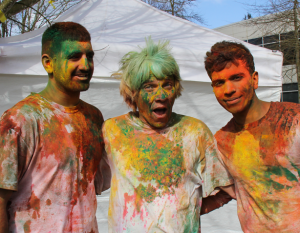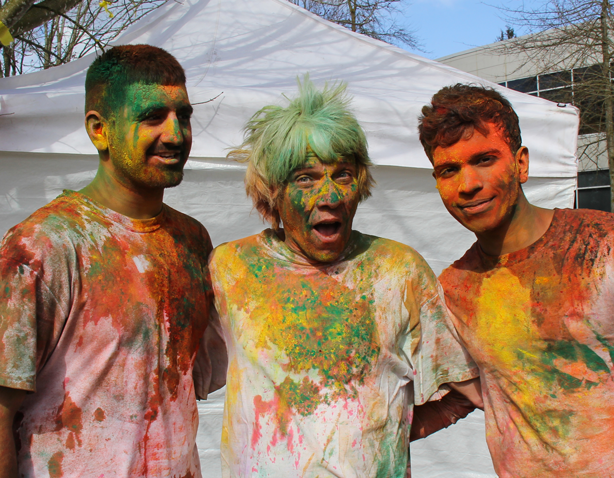Print Edition: March 19, 2014

If the irresistible thump and jingle of bhangra music didn’t draw you over to the celebrations at U-House on Friday afternoon, maybe the spicy smell of samosas did. Or maybe it was the sight of students smeared from head to toe in shocking shades of red, orange, green, and yellow paint.
It was the perfect day for the celebration of Holi, the Indian festival of spring: blue skies and warm breezes, buds swelling on the trees, crocuses beginning to poke out of the earth. Many of the students were jacketless and in sandals. Students gathered outside for the traditional game of “playing Holi,” where revellers throw handfuls of bright powdered dye called gulal on each other. Celebrants wear white clothing like a canvas, and the brilliant dye dusts their skin, faces, and hair, turning entire villages — or campuses — into a riot of colour.
“Holi is the celebration of water and colour, the time when flowers start blossoming,” Rajnish Dhawan, acting director of the Centre for Indo-Canadian Studies, explained to me. “All of the colours of Holi represent the different flowers and their meanings. Everywhere there is a mood of joyousness, the archetypal mood of spring.”
Dhawan recounted the Hindu origin story of Holi to me: the demon Hiranakashap had a pious young son, Prahlad, who worshipped the god Vishnu. Hiranakashap was unable to persuade his son to give up his religious beliefs, and finally decided to kill him. He seated Prahlad in the lap of Holika, the boy’s demon aunt who had a boon that protected her from fire, and set fire to them both — but when the flames died down, Holika had been reduced to ashes and Prahlad had been saved by the intervention of Vishnu. The story teaches us the universal power of good over evil, and the holiday takes its name from the burning of Holika.

Dhawan also told me another story from Hindu culture of how the god Krishna would go to his lover Radha’s village to play Holi, but was chased away for his cheekiness. People still come to that village from all over the world for a massive seven-day celebration of Holi, during which women playfully beat men in a show of chiding them just as Krishna was chided.
The campus celebrations didn’t involve any beatings, but there was plenty of good cheer. There’s just something about a seasonal festival full of dancing, music, tasty food, and good old-fashioned paint-throwing that draws people together.
“There are over 300 religions in India, and all of them are different,” student volunteer Sourav Aggarwal told me. “But everyone celebrates Holi.”
After the free samosas were handed out, four barefoot bhangra dancers in shimmering green, gold, and white uniforms got up in front of the tightly-packed crowd and danced. Many of the faces in the crowd watching them were not Indian, and many of the people I spoke to had never heard of Holi before that morning. The students lining up for samosas, wiping gulal off their faces, and wishing each other “Happy Holi!” represented dozens of different backgrounds — a beautiful reminder of UFV’s astonishing diversity.
Bumping into Rajnish Dhawan once more in the crowd, I commented on how cheerful and friendly everyone seemed to be. He smiled.
“That’s how we celebrate spring,” he said, nodding.
Student Life’s Martin Kelly, whose hair was tinted green with gulal, also stopped to chat with me. Student Life didn’t organize the event, he explained; it was the students who wanted to celebrate. Students Gurv Gill and Shyna Kandra were the driving force behind the event, but many others volunteered their time and energy to share the celebration of Holi with the rest of campus.
“The stuff that people really carry with them from school happens outside the classroom,” said Kelly, sweeping his arm around us at the crowd of students. “When I’ve got Muslim elves at my Christmas party, when we’re seeing Indian faces at Chinese New Year and Scottish and German students at Holi, you can see that the cross-cultural connections are being made.”
Sukhmani Dhaliwal, another student who had volunteered for the event, agreed.
“It’s not just Punjabis here, it’s everyone,” she said. “I’m meeting people I never would have otherwise.”
I saw what she meant as I looked around the room: white kids laughing as they learned how to shimmy to bhangra, Indo-Canadians introducing Korean exchange students to their first samosas, Muslims chatting with Sikhs and atheists. As Dhawan explained to the crowd, in today’s day and age, throwing gulal isn’t just a fun game, it’s symbolic; the brilliant powder hides the colour of our skin and hair, concealing our differences.
“It makes everyone the same race, the same colour,” he said.


